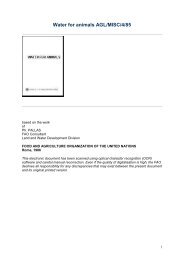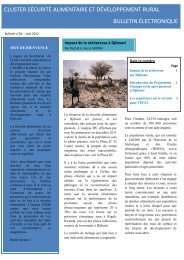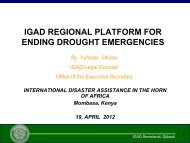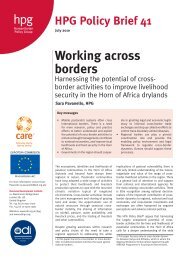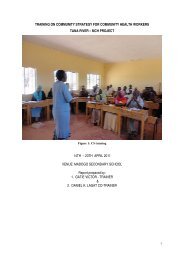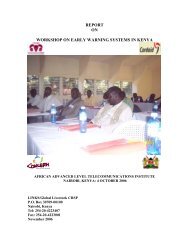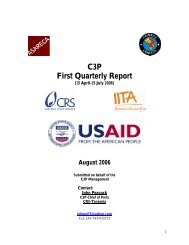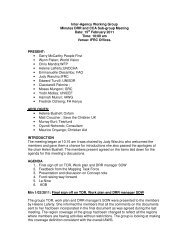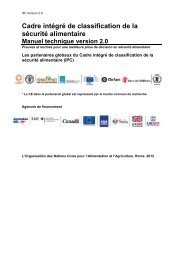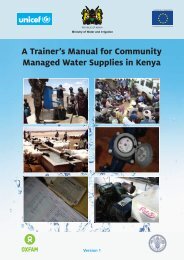• Promote effective participati<strong>on</strong> through <strong>the</strong> involvement <str<strong>on</strong>g>of</str<strong>on</strong>g> recognized instituti<strong>on</strong>s orgroups representative <str<strong>on</strong>g>of</str<strong>on</strong>g> local communities. These groups or instituti<strong>on</strong>s may exist(customary instituti<strong>on</strong>s, water user associati<strong>on</strong>s, pastoral associati<strong>on</strong>s) or may stillneed to be established. For example, customary instituti<strong>on</strong>s may not represent alllivelihood groups in a given area (Muir, 2007), <str<strong>on</strong>g>and</str<strong>on</strong>g> <str<strong>on</strong>g>of</str<strong>on</strong>g>ten do not represent <strong>the</strong> needs<str<strong>on</strong>g>and</str<strong>on</strong>g> views <str<strong>on</strong>g>of</str<strong>on</strong>g> women, while water user associati<strong>on</strong>s may not sufficiently representpastoral needs <str<strong>on</strong>g>and</str<strong>on</strong>g> c<strong>on</strong>cerns <str<strong>on</strong>g>and</str<strong>on</strong>g> generally do not incorporate or build up<strong>on</strong> existingnatural resource management strategies. Fur<strong>the</strong>rmore, existing instituti<strong>on</strong>s haveevolved with time, including traditi<strong>on</strong>al pastoral instituti<strong>on</strong>s. This change must beacknowledged <str<strong>on</strong>g>and</str<strong>on</strong>g> <strong>the</strong> nature <str<strong>on</strong>g>of</str<strong>on</strong>g> <strong>the</strong> change carefully documented to help identifyinstituti<strong>on</strong>al strengths <str<strong>on</strong>g>and</str<strong>on</strong>g> weaknesses, <str<strong>on</strong>g>and</str<strong>on</strong>g> to establish modalities <str<strong>on</strong>g>of</str<strong>on</strong>g> engagement with<strong>the</strong>se instituti<strong>on</strong>s. To date, <strong>the</strong> role <str<strong>on</strong>g>of</str<strong>on</strong>g> customary instituti<strong>on</strong>s is poorly researched inEthiopia <str<strong>on</strong>g>and</str<strong>on</strong>g> development practiti<strong>on</strong>ers <str<strong>on</strong>g>of</str<strong>on</strong>g>ten view <strong>the</strong>se instituti<strong>on</strong>s as fossilizedentities retaining a set <str<strong>on</strong>g>of</str<strong>on</strong>g> characteristics described in historical texts. This is no l<strong>on</strong>ger<strong>the</strong> case, as pastoral customary instituti<strong>on</strong>s have changed with time in resp<strong>on</strong>se tochanging circumstances. Establishing new groups or adjusting <strong>the</strong> c<strong>on</strong>figurati<strong>on</strong> <str<strong>on</strong>g>of</str<strong>on</strong>g>existing groups may thus become necessary.• Simultaneously address o<strong>the</strong>r development needs in <strong>the</strong> rangel<str<strong>on</strong>g>and</str<strong>on</strong>g>s besides <strong>the</strong> needfor water (e.g. human <str<strong>on</strong>g>and</str<strong>on</strong>g> livestock health <str<strong>on</strong>g>and</str<strong>on</strong>g> access to markets) to effectivelyaddress vulnerability <str<strong>on</strong>g>and</str<strong>on</strong>g> poverty l<strong>on</strong>g-term.• Make better use <str<strong>on</strong>g>of</str<strong>on</strong>g> existing research to inform water development planning <str<strong>on</strong>g>and</str<strong>on</strong>g>implementati<strong>on</strong> <str<strong>on</strong>g>and</str<strong>on</strong>g> promote knowledge sharing between practiti<strong>on</strong>ers <str<strong>on</strong>g>and</str<strong>on</strong>g> projects.This can be d<strong>on</strong>e through establishing learning <str<strong>on</strong>g>and</str<strong>on</strong>g> practice alliances.• Create an enabling envir<strong>on</strong>ment where local groups representative <str<strong>on</strong>g>of</str<strong>on</strong>g> water users in agiven area have <strong>the</strong> capacity <str<strong>on</strong>g>and</str<strong>on</strong>g> authority to c<strong>on</strong>struct, operate, manage, <str<strong>on</strong>g>and</str<strong>on</strong>g> maintainwater points, effectively making <strong>the</strong>m implementers ra<strong>the</strong>r than merely recipients <str<strong>on</strong>g>of</str<strong>on</strong>g>development.• Promote <strong>the</strong> c<strong>on</strong>sortium approach to water development am<strong>on</strong>g development <str<strong>on</strong>g>and</str<strong>on</strong>g>humanitarian practiti<strong>on</strong>ers. This approach can help harm<strong>on</strong>ize activities <str<strong>on</strong>g>and</str<strong>on</strong>g> has beenviewed favourably by agencies in <strong>the</strong> water development sector in Ethiopia.Alternatively, link development <str<strong>on</strong>g>and</str<strong>on</strong>g> humanitarian practiti<strong>on</strong>ers to existing (orpotential) technical working groups that h<str<strong>on</strong>g>and</str<strong>on</strong>g>le water issues, such as <strong>the</strong> NaturalResources Management Technical Working Group.86
REFERENCESAbdulahi, M., Adenew, B. (2007). Research <str<strong>on</strong>g>and</str<strong>on</strong>g> advocacy <strong>on</strong> l<str<strong>on</strong>g>and</str<strong>on</strong>g> use right <str<strong>on</strong>g>and</str<strong>on</strong>g> tenure systems inpastoral areas <str<strong>on</strong>g>of</str<strong>on</strong>g> Ethiopia (final draft). Pastoralist C<strong>on</strong>cern Associati<strong>on</strong> <str<strong>on</strong>g>of</str<strong>on</strong>g> Ethiopia (PCAE).Afar Regi<strong>on</strong>al State (2009). Draft Rural L<str<strong>on</strong>g>and</str<strong>on</strong>g> Administrati<strong>on</strong> <str<strong>on</strong>g>and</str<strong>on</strong>g> Use Proclamati<strong>on</strong>. Federal Republic<str<strong>on</strong>g>of</str<strong>on</strong>g> Ethiopia.Behnke R., Kerven C., Teshome A. (2008). Evaluati<strong>on</strong> <str<strong>on</strong>g>of</str<strong>on</strong>g> USAID pastoral development projects inEthiopia, final report. Odessa Centre Ltd., UK for USAID.Bassi, M. (2005). Decisi<strong>on</strong>s in <strong>the</strong> Shade: Political <str<strong>on</strong>g>and</str<strong>on</strong>g> juridical processes am<strong>on</strong>g <strong>the</strong> Oromo-Borana.Trent<strong>on</strong>: Red Sea Press.Behnke, R. (1994) ‘Natural Resource Management in Pastoral Africa’, Development Policy Review, vol.12, 5–27. Overseas Development Institute.Belayhun, M. (2009). <str<strong>on</strong>g>Syn<strong>the</strong>sis</str<strong>on</strong>g> <str<strong>on</strong>g>of</str<strong>on</strong>g> existing knowledge <str<strong>on</strong>g>and</str<strong>on</strong>g> experience <strong>on</strong> <strong>the</strong> provisi<strong>on</strong> <str<strong>on</strong>g>of</str<strong>on</strong>g> watersupplies – with a focus <strong>on</strong> productive water – to pastoral communities in Ethiopia: The case <str<strong>on</strong>g>of</str<strong>on</strong>g> Afar<str<strong>on</strong>g>and</str<strong>on</strong>g> Somali Regi<strong>on</strong>s. Unpublished.Beyene, F. <str<strong>on</strong>g>and</str<strong>on</strong>g> B. Korf. 2008. Unmaking <strong>the</strong> comm<strong>on</strong>s: Collective acti<strong>on</strong>, property rights, <str<strong>on</strong>g>and</str<strong>on</strong>g>resource appropriati<strong>on</strong> in Somali regi<strong>on</strong>, Ethiopia. CAPRi Working Paper 88. Washingt<strong>on</strong>, D.C.:Internati<strong>on</strong>al Food Policy Research Institute.Coppock D Layne (ed.). 1994. The Borana Plateau <str<strong>on</strong>g>of</str<strong>on</strong>g> Sou<strong>the</strong>rn Ethiopia: <str<strong>on</strong>g>Syn<strong>the</strong>sis</str<strong>on</strong>g> <str<strong>on</strong>g>of</str<strong>on</strong>g> pastoral research,development <str<strong>on</strong>g>and</str<strong>on</strong>g> change, 1980-91. ILCA (Internati<strong>on</strong>al Livestock Centre for Africa), Addis Ababa,Ethiopia. 393 pp.Demeke, F. (2008). Guideline for c<strong>on</strong>flict sensitive programming (zero draft). For <strong>the</strong> Running DryInitiative: Empowering poor people to manage water in arid <str<strong>on</strong>g>and</str<strong>on</strong>g> semi-arid l<str<strong>on</strong>g>and</str<strong>on</strong>g>s. CARE Ethiopia.Desta S, Berhanu W, Gebru G, Amosha D (2008). Pastoral Dropout Study in Selected Woredas <str<strong>on</strong>g>of</str<strong>on</strong>g>Borana Z<strong>on</strong>e Oromia Regi<strong>on</strong>al State. Care Internati<strong>on</strong>al Ethiopia.Devereux, S. (2006) Vulnerable Livelihoods in Somali Regi<strong>on</strong>, Ethiopia. Research Report 57, Institute<str<strong>on</strong>g>of</str<strong>on</strong>g> Development Studies (IDS).Elias, E. (2008). Pastoralists in Sou<strong>the</strong>rn Ethiopia: Dispossessi<strong>on</strong>, access to resources <str<strong>on</strong>g>and</str<strong>on</strong>g> dialoguewith policy makers. Dryl<str<strong>on</strong>g>and</str<strong>on</strong>g>s Coordinati<strong>on</strong> Group Report No. 53.Ethiopia Productive Safety Net Programme (2008). Pastoral Pilot ProgressFaal, J., Nicol, A., <str<strong>on</strong>g>and</str<strong>on</strong>g> Tucker, J. (2009) Multiple-use Water Services (MUS): Cost-effective waterinvestments to reduce poverty <str<strong>on</strong>g>and</str<strong>on</strong>g> address all <strong>the</strong> MDGs, RiPPLE Policy Brief 1. RiPPLE: AddisAbaba, Ethiopia.Federal Republic <str<strong>on</strong>g>of</str<strong>on</strong>g> Ethiopia (2007). Summary <str<strong>on</strong>g>and</str<strong>on</strong>g> Statistical Report <str<strong>on</strong>g>of</str<strong>on</strong>g> <strong>the</strong> 2007 Populati<strong>on</strong> <str<strong>on</strong>g>and</str<strong>on</strong>g>Housing Census. Populati<strong>on</strong> Census Commissi<strong>on</strong>.Flintan, F. <str<strong>on</strong>g>and</str<strong>on</strong>g> A. Cullis (forthcoming 2010). Introductory Guidelines to Participatory Rangel<str<strong>on</strong>g>and</str<strong>on</strong>g>Management in Pastoral Areas. Save <strong>the</strong> Children/US, Addis Ababa, Ethiopia.Fuller, N. (ed.) (1999) Managing Mobility in African Rangel<str<strong>on</strong>g>and</str<strong>on</strong>g>s: The Legitimizati<strong>on</strong> <str<strong>on</strong>g>of</str<strong>on</strong>g> Transhumance.L<strong>on</strong>d<strong>on</strong>: Intermediate Technology Publicati<strong>on</strong>s.
- Page 1 and 2:
Synthesis
- Page 4 and 5:
TABLE OF CONTENTSLIST OF ACRONYMS..
- Page 6 and 7:
ACKNOWLEDGMENTSI would like to exte
- Page 8 and 9:
LIST OF ACRONYMSACDI/VOCAACFAFDCDDC
- Page 10 and 11:
EXECUTIVE SUMMARYWater development
- Page 12 and 13:
understanding <str
- Page 14 and 15:
Agreed upon guidelines for water de
- Page 16 and 17:
• Make better use of</str
- Page 18 and 19:
to inform their own work an
- Page 20 and 21:
Within pastoral areas, it is recogn
- Page 23 and 24:
Section 2. Overview of</str
- Page 25 and 26:
Dohrn, 2006). Spatially variable ra
- Page 27 and 28:
The following broad overview touche
- Page 29 and 30:
In areas of adequa
- Page 31 and 32:
observed response was for individua
- Page 33 and 34:
Specific to water development, seve
- Page 35 and 36: Section 3. Water development todayT
- Page 37 and 38: Eliciting payments for water from l
- Page 39 and 40: ureaus 25 . The ministry’s interv
- Page 41 and 42: National policy paints a conflictin
- Page 43 and 44: will be given to pastoralists to en
- Page 45 and 46: Water supplyGovernance and<
- Page 47 and 48: vulnerable to conversion for other
- Page 49 and 50: • Agro-pastoralists’ priorities
- Page 51 and 52: Although the WSDP principles are se
- Page 53 and 54: The Universal Access ProgramThe Uni
- Page 55 and 56: • Help ensure that public works d
- Page 57 and 58: However, the development model for
- Page 59 and 60: Figure 4: Proposed pilot la
- Page 61 and 62: Many international and</str
- Page 63 and 64: Furthermore, attention is given to
- Page 65 and 66: CARE International, under the GWI,
- Page 67: and traditional me
- Page 70 and 71: • Understand exi
- Page 72 and 73: 4.2 Key observations in the water d
- Page 74 and 75: epresent a firm attempt to preserve
- Page 76 and 77: learning from NGO experiences in Bo
- Page 78 and 79: However, there are currently no spe
- Page 80 and 81: 4.3 Conclusion, ways forward <stron
- Page 82 and 83: In sum, pastoralism as a livelihood
- Page 84 and 85: • Water interventions selected sh
- Page 88 and 89: Gebre-Mariam, A. (1982). Organizati
- Page 90: Schimann P. and Ph



